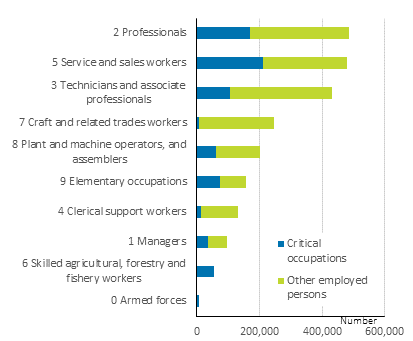Published: 9 November 2020
Number of persons working in critical occupations was 735,000
According to Statistics Finland's employment statistics, there were 2.4 million employed persons in Finland in the last week of 2018. A total of 735,000 persons worked in critical occupations, or 31 per cent of all employed persons. Around 23 per cent of them had a child aged under ten living in the same household. Of those working in critical fields, 67 per cent were women (490,000 persons).
On the least detailed level of the Classification of Occupations, armed forces (8,000 persons) and agricultural and forestry workers, etc. (53,000 persons) were defined as entirely critical.
Numbers of critical occupations and other employed persons on the least detailed level of the Classification of Occupations in 2018

The Prime Minister’s Office published a list of critical occupations in corona spring 2020. Some of these occupations were defined as 100% critical and some as 50% critical. This text deals with occupational groups classified as entirely critical from the main employment relationships of employed persons during the last week of 2018. The occupations examined here are based on a list drawn up by the Ministry of Economic Affairs and Employment.
The number of critical occupations is 100 on the 4-digit level of the Classification of Occupations. In total, there are 420 occupations on the 4-digit level in the Classification of Occupations 2010.
After armed forces and agricultural and forestry workers, etc., most employed persons in critical occupations relative to all employed persons in the occupational group concerned were in the categories elementary occupations (48%), service and sales workers (43%) and managers (38%).
Only two per cent of craft and related trades workers were defined as critical. These were on the 3-digit level of the occupational group 751 Food processing and related trades workers.
In five years, the number of employed persons in critical occupations decreased by 1,000 persons, or by around one per mil. At the same time, the number of all employed persons increased by 72,000 persons, or by three per cent.
Geographical distribution of critical occupations
Examined by area, the highest numbers of persons working in critical occupations were living in Uusimaa (205,000 persons), Pirkanmaa (66,000) and Southwest Finland (65,000). In relative terms, compared to all employed persons in the region, most representatives of critical occupations were found in Central Ostrobothnia (11,000 persons, 39%), South Ostrobothnia (30,000, 38%) and Kainuu (11,000, 38%).
Only in Uusimaa (26%) the share of persons working in critical occupations of all employed in the region was under 30 per cent.
Relative to the population, the numbers of employed persons in critical occupations were highest in North Ostrobothnia (34%), South Savo (30%) and Southwest Finland (30%). Relative to the population, under 10 per cent of employed persons were working in critical occupations in Kymenlaakso, North Savo, Kainuu and South Karelia.
Shares of critical occupations of all employed persons by region of residence in 2018

Persons with families in critical occupations
In 2018, there were 170,000 adults in critical occupations with whom at least one child aged under 10 lived in the same dwelling. These parents accounted for 23 per cent of all those working in critical fields. Children aged under 10 have been selected for the examination because one parent may take temporary child care leave if a child of that age falls ill.
For persons with families with children, the shares of those in critical occupations (occupations with over 10 persons) were biggest in 2018 among midwives (970 persons, 40%), air traffic controllers (110, 39%), pharmacists (560, 38%), railway brake, signal and switch operators (750, 37%) and ambulance workers (1,200, 35%).
Shares of persons with families working in critical occupations by occupational group on 4-digit level in 2018

For persons with families with children, the shares of those in critical occupations (occupations with over 10 persons) were biggest in 2018 among midwives (970 persons, 40%), air traffic controllers (110, 39%), pharmacists (560, 38%), railway brake, signal and switch operators (750, 37%) and ambulance workers (1,200, 35%).
In 2018, the number of mothers of children aged under 10 working in critical fields totalled 118,000, which was 16 per cent of all persons working in critical fields. The most common occupational groups for mothers were nurses (20,000, 30% of all women in the occupational group), health care assistants (16,000, 23%) and child care workers (10,000, 25%). Mothers' ten most common critical occupations employed 85,000 persons, which represented 72 per cent of all mothers working in critical occupations.
Correspondingly, fathers of children aged under 10 working in critical fields numbered 54,000 in 2018, which was seven per cent of all persons working in critical fields. The most common occupational groups for fathers were heavy truck and lorry drivers (8,000, 20% of all men in the occupational group), livestock and dairy producers (2,700, 21%) and secondary education teachers (2,500, 30%). Altogether 25,000 persons are employed in fathers' ten most common critical occupations, which was 10 per cent of all fathers working in critical occupations.
In Statistics Finland's employment statistics for 2018, the occupations of wage and salary earners and entrepreneurs aged 18 to 74 according to their main employment relationship in the last week of the year have been classified into occupational groups according to the Classification of Occupations 2010.
Source: Employment Statistics, Statistics Finland
Inquiries: Juho Keva 029 551 3061, Elina Mikkelä 029 551 2973, info@stat.fi
Head of Department in charge: Hannele Orjala
Publication in pdf-format (339.3 kB)
- Reviews
- Tables
-
Tables in databases
Pick the data you need into tables, view the data as graphs, or download the data for your use.
Appendix tables
Updated 16.10.2020
Official Statistics of Finland (OSF):
Employment [e-publication].
ISSN=2323-6825. Industry, employer sector and jobs 2018. Helsinki: Statistics Finland [referred: 29.12.2025].
Access method: http://stat.fi/til/tyokay/2018/04/tyokay_2018_04_2020-11-09_tie_001_en.html

